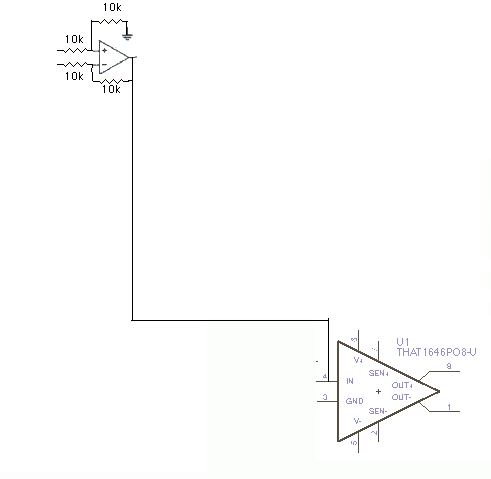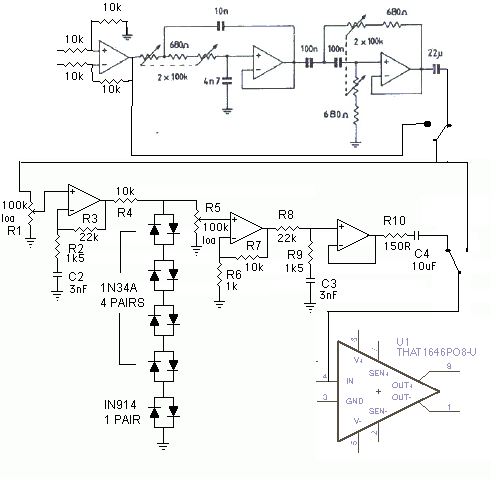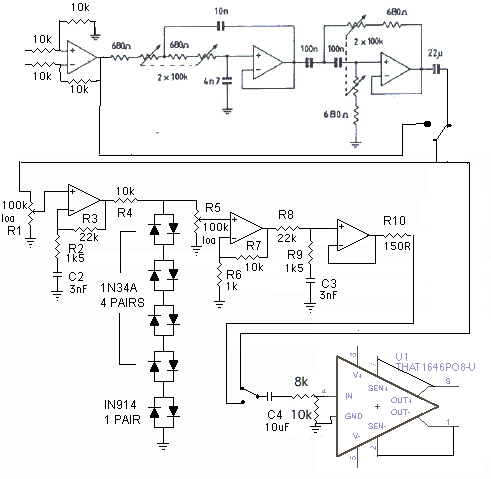briomusic said:
option a: reducing gain at unbalancing stage - disadvantage: small signals don't drive into saturation, even with R1 fully turned up and R4 removed.
option b: doubling R8 to 44k - works for tape sat, but not if tape sat is in bypass and only filters are used.
With -6dB loss in your unbalancing line receiver, without your 8K/10K attenuator and +6dB gain from THAT1646, there should be unity gain in tape sat bypass mode as well.
I wasn't talking R8 but R3 for same drive. This is a non-inverting bandwidth limited gain stage with voltage gain of 1+R3/R2 in the pass band, giving 15.67 or +24dB. If you subtract 6dB from input side, doubling R3 will make up this 6dB loss if your opamp can do so. A 22pF-33pF cap across this feedback resistor might help oscillating if required. Compression starts when signal exceeds the ~4.6V from the 4 germanium+1 silicone diode drops, so with current limiter/voltage divider R4 10K and R5 100K you'll need about 5V at 1st opamp output before compression takes effect.
option c: voltage divider before balancing chip - "affects performance" - but in what way? Is the 8k adding to the output impedance of the tape sat or the input impedance of the balancing chip? (I never understand that bit). Would it be better to have smaller values, i.e. 4k and 5k? I would still prefer to get this version working as it works in any configuration (only filter, only tape, both).
Your 8K/10K attenuator with chips 5K input impedance in parallel to your 10K shunt actually drops signal by 10dB. A 3.3K instead of 8K might be a better fit if you keep your gain staging as drawn.
From equivalent circuit diagram the THAT1646 internally has differential inputs, connecting thru 5K resistors to the outside world. The inverting input already has one side of these 5K resistors internally connected to gnd, so any different value greater than zero ohm in front of the non-inverting input will degrade CMRR and as follow up the chips ability to supress longitudinal errors OCMR. Your 18K attenuator, consisting of a 8K series and 10K shunt resistor will increase the internal 5K, connecting to non-inverting input to 13K and the chips input impedance of 5K is reduced by paralleling your 10K shunt resistor.
also....what's wrong with C2 being 3nF? according to this:
http://home3.netcarrier.com/~lxh2/tapesat.html it is part of the (2.25kHz) emphasis/de-emphasis applied by R2/C2 and R9/C3?
Sorry, nothing wrong with C2. R2/C2 is a HPF with 6dB/oct rolloff set for 35kHz. Voltage gain of this non-inverting stage will always be greater than 1, so with 6dB/oct slope this stage increases gain above 2.262 Hz, close to perfect for tape rollover frequency 0/2274Hz for IEC standard 7 1/2 ips. Use 1.5nF for C2 and C3 for 0/4547Hz IEC 15 ips simulation or 2.2nF for C2 and C3 and 33nF in front of R1 for 50/3180Hz NAB standard 7.5 and 15 ips.
I could be wrong though.











![Soldering Iron Kit, 120W LED Digital Advanced Solder Iron Soldering Gun kit, 110V Welding Tools, Smart Temperature Control [356℉-932℉], Extra 5pcs Tips, Auto Sleep, Temp Calibration, Orange](https://m.media-amazon.com/images/I/51sFKu9SdeL._SL500_.jpg)


























